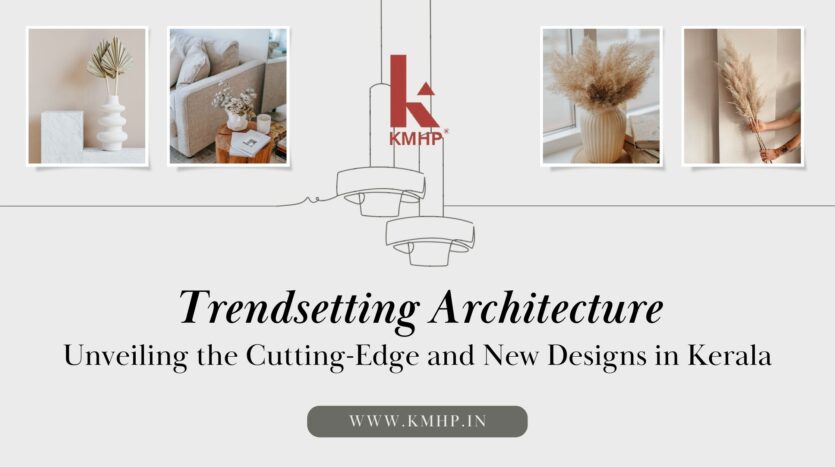Kerala. In recent years, Kerala has emerged as a hub for cutting-edge and innovative architecture and new housing designs.. showcasing designs that are both sustainable and futuristic. From eco-friendly buildings to experimental forms, Kerala’s architects are pushing the boundaries of traditional building design and creating structures that are both functional and aesthetically pleasing. In this article, we will explore the latest trends and developments in Kerala’s architecture scene, highlighting the most inspiring and trendsetting buildings in the state.

Embracing Sustainability: Eco-Friendly Designs in Kerala
The need for sustainable and eco-friendly buildings has led to a rise in demand for green technologies in building construction. Architects and designers are now incorporating features such as solar panels, rainwater harvesting systems, and energy-efficient lighting to create sustainable buildings that minimize their ecological impact. Buildings are also designed to optimize natural lighting and ventilation to reduce the need for artificial lighting and air conditioning.
Incorporating Green Technologies in Building Construction
One of the major trends in eco-friendly design is the use of green technologies in building construction. This includes the use of materials that are sustainable and have low carbon footprints, as well as the incorporation of renewable energy sources such as solar panels and wind turbines to power buildings. The use of recycled materials and the reduction of waste in the building process are also becoming increasingly popular.
Designing Buildings for Optimal Natural Lighting and Ventilation
Designers are now focusing on creating buildings that are optimized for natural lighting and ventilation. This means designing buildings that use natural light and airflow to minimize the need for artificial lighting and air conditioning, not only reducing energy consumption but also creating healthier indoor environments for building occupants.
Futuristic Designs: Incorporating Technology into Architecture
Modern technology has opened up new possibilities in architecture, leading to the development of futuristic designs that incorporate smart technologies such as AI and robotics. These designs not only prioritize functionality but also create structures that are visually stunning and awe-inspiring.
The Use of Smart Technologies in Building Design
The use of smart technologies in building design is becoming increasingly common, with the integration of systems such as smart lighting and HVAC controls, automated shading systems, and smart security systems. These systems can be controlled remotely, making buildings more energy-efficient and easier to manage.
Designing Buildings for the Future – AI and Robotics
The integration of AI and robotics in building design is a rapidly growing trend that is transforming the architectural landscape. Architects are using AI to optimize building designs for maximum efficiency, while robotics is being used to automate construction processes, making them faster and more accurate.
Blending Traditional and Modern Styles: The Rise of Contemporary Vernacular Architecture
The revival of vernacular architecture in Kerala is a trend that reflects a growing appreciation for traditional architectural styles that incorporate modern elements. This style of architecture is characterized by the use of local materials and traditional building techniques, combined with contemporary design features.
Exploring the Fusion of Traditional and Modern Styles
Contemporary vernacular architecture blends traditional and modern styles seamlessly, creating buildings that are both functional and aesthetically pleasing. This style of architecture is gaining popularity among designers and architects, as it allows them to create structures that reflect the cultural identity of the region while also incorporating modern design elements.
The Revival of Vernacular Architecture in Kerala
The revival of vernacular architecture in Kerala is a trend that is gaining momentum, as designers and architects aim to create sustainable buildings that preserve the cultural heritage of the region. This style of architecture not only reflects the local culture but also creates a sense of community and identity, making it a popular choice for public buildings such as schools, cultural centers, and museums.
Unconventional Structures: Exploring Experimental Forms in Kerala’s Architecture
When it comes to architecture, Kerala is known for its traditional designs and styles. However, in recent years, there has been a surge in unconventional structures that challenge the boundaries of traditional building design. From unique shapes to unusual materials, architects in Kerala are pushing the limits and experimenting with new forms. These structures not only stand out visually but also offer new functionalities and purposes.
Challenging the Boundaries of Traditional Building Design
Breaking away from the traditional styles, architects in Kerala are creating buildings that are both functional and aesthetically pleasing. For instance, the Kochi International Airport Terminal designed by Gensler is like a giant shell, with its curved facade and futuristic design. Similarly, the Circular House in Kottayam designed by Grid Architects is a unique structure that mimics the shape of a conch shell. It not only offers a new perspective on residential design but also maximizes the use of space.
Pushing the Limits – Unusual Materials and Shapes in Building Design
In addition to unique shapes, architects are also experimenting with materials like bamboo, mud, and terracotta. The Bamboo Symphony in Thiruvananthapuram, designed by Vinu Daniel, uses bamboo in its entirety, creating a sustainable and eco-friendly structure. Another example is the Mud Mirror House in Kutch designed by Anagram Architects. The house’s facade is made entirely of mud and mirrors, giving it a distinct reflective quality that makes it stand out.
Affordable Housing Solutions: Innovative Designs for Low-Income Communities
Kerala’s rapid urbanization has led to a demand for affordable housing. Architects are rising to the challenge and creating innovative designs that not only cater to the needs of low-income communities but are also sustainable and eco-friendly.
The Importance of Affordable Housing in Kerala’s Urbanization
Urbanization has brought about a rise in demand for affordable housing in Kerala. Architects are recognizing this need and are creating designs that cater to the specific requirements of low-income communities. Affordable housing solutions cater to the needs of the urban poor and provide them with a safe and comfortable living space. This not only improves their quality of life but also contributes to the overall development of the state.
Creative Design Solutions for Sustainable and Affordable Housing
Architects are incorporating sustainability principles into their designs, creating structures that are not only affordable but also eco-friendly. The Cactus House by Studio Alternative is an example of such a design. The structure is made entirely of local materials and uses solar panels for energy. Another example is the Lifepods project by Manasaram Architects, which offers low-cost housing solutions using sustainable materials like bamboo and mud.
Public Spaces and Greenery: Revamping Urban Landscapes with Architecture
Urban landscapes in Kerala are being revitalized with the integration of public spaces and greenery into building design. Architects are using innovative techniques to create lively and sustainable public spaces that contribute to the city’s overall ambiance.
Using Architecture to Create Lively and Sustainable Public Spaces
Architecture is no longer limited to just buildings but extends to public spaces and urban landscapes as well. Architects are using design to create spaces that are not only aesthetically pleasing but also functional. For instance, the Green Loop in Thiruvananthapuram designed by Integrated Environs and Studio Ardete is a public space that promotes cycling and walking. The design incorporates eco-friendly features like rainwater harvesting, solar lighting, and an irrigation system.
Creating Green Urban Oases – The Integration of Nature into Building Design
The integration of nature into building design has become a popular trend in Kerala’s architecture. Architects are creating green urban oases that provide relief from the hustle and bustle of urban life. The Kozhikode Beach Promenade by Jalal Consultants is a prime example of this. The design incorporates natural elements like trees and water bodies, creating a space that is both peaceful and rejuvenating.


